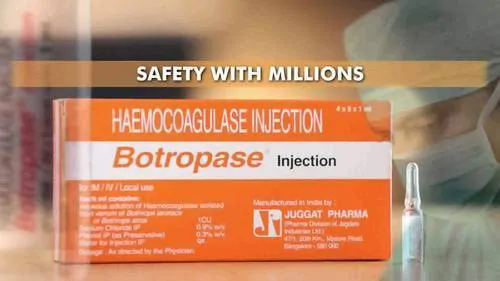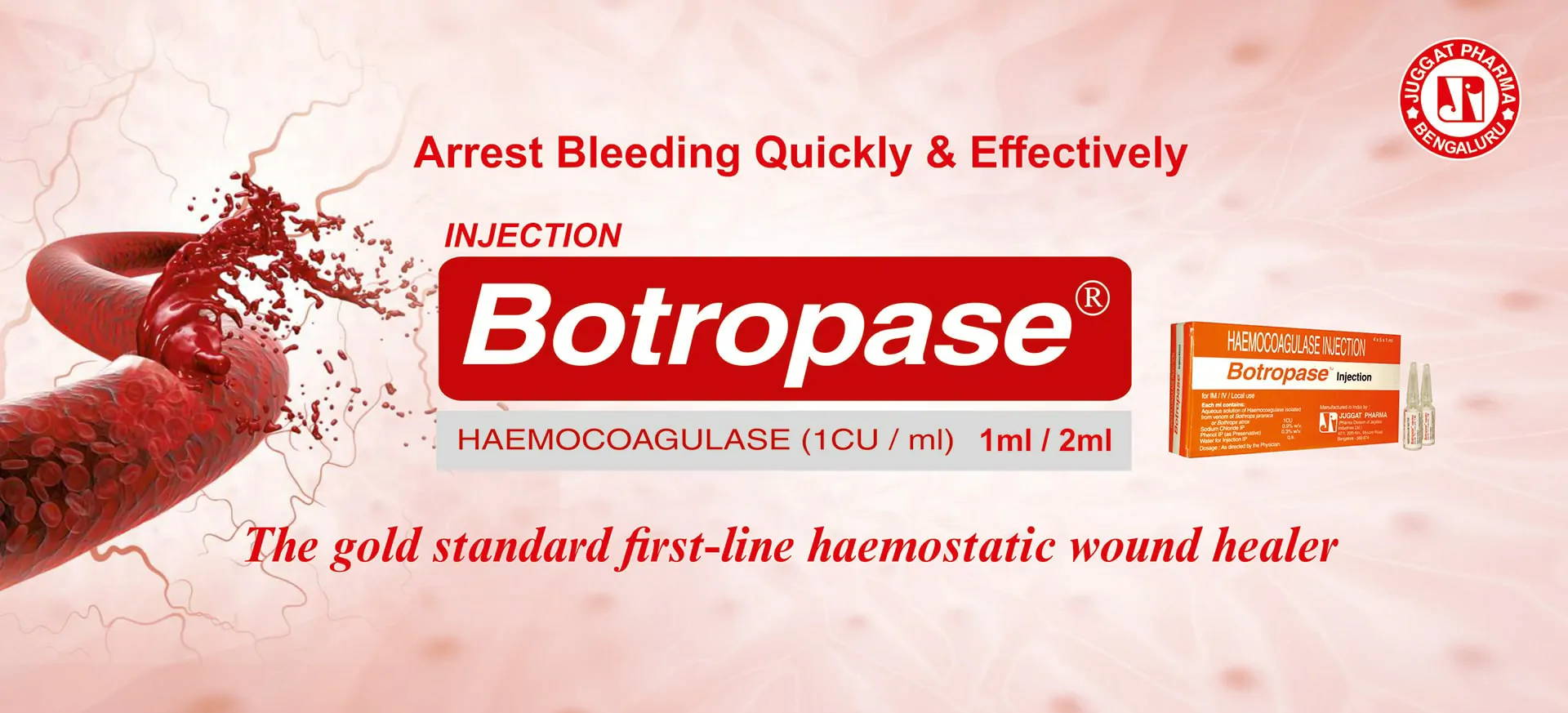
Introduction
Controlling bleeding is life-saving procedure and Botropase is an excellent drug to arrest capillary bleeding effectively. Over six decades, Injection Botropase has helped many doctors overcome life-threatening complications in both surgical and non-surgical cases by controlling capillary bleeding and ensuring faster wound healing. More than a billion dose of Botropase has been used for controlling haemorrhagic condition with no sever adverse drug reaction. Botropase is safe from infant to elderly. Botropase has proven its efficacy in controlling capillary bleeding of different etiology. Unlike all other Hemostatic drugs, Botropase is effective in coagulopathies and during concomitant use of blood thinning agents.
History
Botropase is an enzyme fraction, which is isolated, purified and standardised from the venom of Bothrops atrox / Bothrops jararaca, which are predominantly found in South American region. These are the oldest snake venom extracted and lot of research work were conducted across the world. Snake venom contains number of proteases, which can speed up hemostasis as clotting factor activators, factor X activator and thrombin like enzyme. Klobusitsky and Konning isolated haemocoagulase in 1935, from the venom of Bothrops jararaca and subsequently defined its pharmacological and toxicological properties. Since then extensive studies were conducted with regard to usage of haemocoagulase in haemorrhagic condition. In India, haemocoagulase was introduced as Botropase in late 1960’s and continues to be manufactured by Juggat Pharma, Bengaluru.

Standardisation of Haemocoagulase (Botropase)
Enzyme is measured by its activity rather than weight. We standardise haemocoagulase by its enzymatic activity through its reaction with substrate Fibrinogen. So, all the batches of Botropase is standardized with its activity against fibrinogen with respect to time.
In India, we follow coagulation unit formulated by the Brazilian investigators who discovered haemocoagulase.In other countries standardization unit differ. In China it is known as Klobusitsky units, in Korea it is mentioned as NIH units and in some other country even it is called as IU (International Units). But, all standardization of haemocoagulase Inj. across the world always done with respect to its reaction time with fibrinogen.
Botropase: 1Coagulation Unit
- 1 CU = One Coagulation Unit.
- It expresses the power of coagulation (potency of Botropase).
- An ampoule of Botropase is said to have haemocoagulase solution of 1 CU/ml strength if it can coagulate freshly prepared fibrinogen solution (0.4% w/v) in about 30 seconds.
Mode of Action of Botropase
- Botropase directly converts fibrinogen to fibrin monomer. Botropase has thrombin like action.
- Botropase increases the thromboplastin or thromboplastic activity: thus, there is an enhanced conversion of prothrombin to thrombin, which in turn converts more of fibrinogen to fibrin monomer.
- Botropase stimulates or reinforces the biological glue (Factor XIII A), thus hastens conversion of fibrin monomer to polymer.
- Fibrin clot produced by Botropase is highly resistant to digestion by PLASMIN.
- Botropase promotes the interaction of platelets with fibrin clot.
- Botropase signals faster cell division to promote faster wound healing.
- Botropase produces a fibrin-fibrinonectin bridge, which encourages the growth of collagen fibres beneath it (collagen, a supportive protein is required for wound healing – new cell formation).
- Botropase promotes the growth of capillaries in the wound space, which encourages wound healing.
- Botropase produces a cosmetically elegant linear scar by reducing keloid formation.
- Botropase interact with Platelets and increases platelet growth factor (PGF) release.
- Botropase avoids tissue oozing, hematoma formation, withdrawal oozing and maintains haemodynamic balance.
Indications
Main Therapeutic use of Botropase are as follow
-
Effective as Prophylactic, in pre- & post operative and in emergent oozes
- Abdominal Surgery, General Surgery, Endoscopic Surgery, Laparoscopic Surgery, Trauma
-
Effective in Gynecological Surgery
- C- Section, Hysterectomy, Episiotomy, Vaginal Laceration, Vaginal Delivery
-
Faster control of bleeding in
- Menorrhagia, Metrorrhagia, PPH
-
Control of bleeding in ENT procedure
- FESS, Tonsillectomy, Adenoidectomy, Tymphanoplasty, Epistaxis. DCR
-
Dental Procedure
- Tooth Extraction, Gum Bleeding, Biopsy, Root canal
